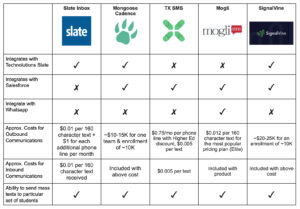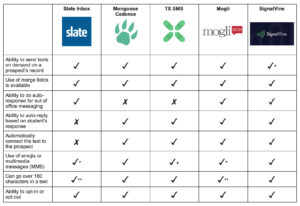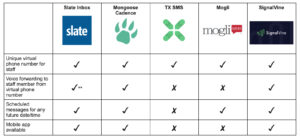Did you know?
- Globally 5 billion people send and receive SMS
- 80% of the total population of North America sends and receives SMS
- SMS has a 98% open rate compared to emails
- SMS has a 19% click-through-rate compared to 4% for emails
- 95% of the texts that are read are responded to within 3 minutes of delivery
- Education is ranked #10 in the top 10 industries using SMS to communicate with “customers”
- Students want schools to text them, and there is growing evidence suggesting that SMS communication results in higher yield rates
Moving from Transactional to Action-Based Campaigns
As the data suggests, texting is nothing new. Almost everyone has the ability to send or receive texts from their phone. We interact with our friends, our coworkers, our bosses, and even companies through text. Many of us rely on these texts to remind us of appointments. And reminders are what admissions professionals primarily have used text for in recent years. Reminding prospects of events they have registered for, reminding them of deadlines, or inviting them to register for events. But what would happen if we moved from generic transactional texts to more personalized, action-based texting?
So instead of a generic, “register for this event” text that goes to every prospect in your system, what if you had texts that were sent out to prospects who have registered for 2 or more events that relate to financial aid inviting them to look into the great scholarship or grant opportunities at your institution? And what if a prospect has visited pages on your website pertaining to athletics in the month of September? Shouldn’t they get a text inviting them to the panel on Athletics at the open house that is happening in a month?
If a prospect opts-in and is willing to exchange text messages with the admissions team, they are already quite interested in your institution. Therefore, by giving prospects information relevant to where they are in the process, as well as content directly relevant to their interests or questions, you can influence a prospect’s ability to understand and engage more with your institution. This engagement leads to a greater knowledge of your institution and whether it is a good fit for them and their interests and future career aspirations. Knowledge is power and what is easier than getting that power in a bite-sized text?
Determining Which Tool is Right for Your Institution
When looking at texting tools, the first instinct may be to procure a product with the most bells and whistles. However, there are many questions that need to be answered to help you find the right texting platform for your institution. Some examples of the types of questions your institution needs to ask are: What are your short term and long-term goals with texting? For example, at go-live, do you want to send 1:1 SMS to students or do you want to send bulk SMS or both? Are you sending bulk SMS texts to all students or only to segmented populations? Do you plan to upload a contact list to the texting platform? Do you prefer short code (5 or 6 digit telephone number) or long code (10 digit number in most countries) numbers? Are multiple users going to send text messages? Do you want the SMS platform to integrate seamlessly with your CRM? If a texting platform is not built on top of a CRM or if it does not easily integrate with your existing CRM, what resources do you have available to make this integration happen? Does your advanced communication strategy include automated responses based on student text messages or chatbots?
Depending on your institution’s priorities, communications strategy, and resource availability, there are various kinds of texting platforms to choose from. To get your feet wet, you may be looking for a simple tool where you upload a list, send transactional emails and pay as you go. Though this is not a bad choice, integration with your CRM is typically not possible and you will encounter additional challenges with creating sustainable communication strategies as you scale. Students not only want to be reminded of next steps and receive event communications, but also want to be guided through the enrollment process. Leveraging prospect information by integrating the texting platform with your existing CRM or SIS allows you to construct personalized, relevant, and timely messages to students depending on where they are in the admission or enrollment process.
Let’s take a look at a few solutions you may consider.
We will start with TargetX’s solution, TX SMS allows sending 1:1 and personalized bulk SMSes, creation of message templates, customization of the opt-out and opt-in messages, setting up multiple long code numbers and finally, associating multiple numbers, users and inboxes to different “inboxes”. An account with Twilio is required to start using TX SMS, and the costs for usage are charged by Twilio. Limited automation of responses to FAQs is possible using pre-populated answers, but you cannot schedule messages, create out-of-office messages or chatbots.
Technolution’s Slate is another CRM with native texting functionality. Slate allows the admissions team to send 1:1 texts from the person record, as well as send personalized bulk (one-time, scheduled or recurring) SMS texts to segmented populations via Deliver. Setting up virtual numbers and SMS credits is easy. Slate will automatically opt prospects out if they reply with standard opt-out terms such as ‘STOP’ or ‘Unsubscribe’, and consent to receiving SMS must be configured by the institution on their prospect-facing forms. Prospects are able to respond to the texts that they receive, but these replies are housed in the Inbox and aren’t directly actionable off of the person record’s timeline. You can set up out of office messages as auto-responses but setting up auto-responses based on texts back from students (like “Y” or “N”) is currently not possible.
Institutions with more sophisticated demands for their communications turn to other texting platforms that integrate with their CRM to supplement the texting capabilities of their original platform. There are many options out there for you to consider. We chose just a few for a deeper dive to help you understand how they move beyond the standard functionality provided natively within your CRM.
We chose to look at Signal Vine, Mongoose’s Cadence, and Mogli. Each of these platforms have their own pros and cons associated with them and while we detail a few of these in the paragraphs below, the feature-based comparison table at the end of this article can be really useful in seeing at a glance what tools might be right for your institution.
With Signal Vine, you are able to use the data from Slate, TargetX or other CRMs to send timely targeted messages. Signal Vine also comes with an AI-Powered virtual advisor built using their Blended Messaging® approach. The virtual advisor automates responses to frequently sought topics and can flag the admissions staff with the student messages that were not recognized by the platform. This helps in steering staff support to those students who really need it. Signal Vine’s integration with Salesforce can be two-way, which allows student responses to be synced back with the student record. We have many clients, especially community colleges using Signal Vine, and have it integrated with their Salesforce CRM.
Mongoose’s Cadence is another popular texting tool. Mongoose also has a platform called Harmony which is an intelligent chatbot. With Cadence, you are able to send 1:1 or bulk messages to segmented populations, create templates, allow opt-in/opt-out and create multiple virtual phone numbers. Other cool features of Cadence include forwarding voice calls to staff members when students call a virtual number (as does Signal Vine) and setting up conditional dynamic responses. Cadence also integrates with SISes and CRMs, and this presents a plethora of opportunities to keep students engaged and informed.
For institutions using Salesforce, a good texting application is Mogli. Along with having the basic functionality like sending 1:1 and bulk texts, you are also able to send Whatsapp messages which helps in reaching a large international population. Advanced features include sending surveys, allowing students to vote through texts, setting up chatbots, being able to convert text and audio files to voice calls and leveraging Salesforce’s automation functionality to create custom notifications, reminders, update the Salesforce objects, send messages based on the student’s native language, and much more. Despite being a powerful texting application, a big drawback is that you cannot use Mogli if you are not a Salesforce user.
These are just a few of the commonly used texting platforms in higher ed, but there are always more options if you think that these don’t fit the bill. Making texting a persistent channel in your communication strategy should be a priority for you and it does not have to be intimidating. The most important step is to identify your goals and determine how SMS will help fulfill these goals, develop a texting strategy and find the right platform to make this happen!
A Few Tips to Keep in Mind for SMS:
- Always get consent, and verify SMS consent is available before sending a message (Mogli offers a good article on Opt in requirements)
- Consider getting annual opt-in
- Don’t include too many URLs
- Selectively use bit.ly URLs (this is for for email and SMS; URL shorteners, especially bit.ly have been know to trigger spam filters)
- Consider if the information you are sending is relevant and valuable before hitting send
How Do They Compare?
Interested in comparing these tools to understand how they differ with features and functionality? Check out the chart below:
Featured-Based Comparison Table



*Use of emoji reduces the message counter for a single message to 70 characters vs. 160.
**Increases your cost.
+Only emojis. Does not support images.
^In Salesforce

